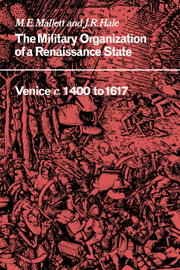Book contents
- Frontmatter
- Contents
- List of illustrations
- Acknowledgements
- References and abbreviations
- Map 1 The Terraferma in the fifteenth and sixteenth centuries
- Map 2 The empire da Mar
- PART I c. 1400 to 1508
- Introduction: the European context 1400–1525
- 1 The beginnings of Venetian expansion
- 2 The composition and role of the army in the fifteenth century
- 3 Military development and fighting potential
- 4 The organization and administration of the Venetian army
- 5 Control and policy making
- 6 Soldiers and the state
- 7 Venice and war
- PART II 1509–1617
- Conclusion: the European context 1525–1617
- Appendix Infantry wages in the sixteenth century
- Select bibliography
- Index
3 - Military development and fighting potential
Published online by Cambridge University Press: 22 October 2009
- Frontmatter
- Contents
- List of illustrations
- Acknowledgements
- References and abbreviations
- Map 1 The Terraferma in the fifteenth and sixteenth centuries
- Map 2 The empire da Mar
- PART I c. 1400 to 1508
- Introduction: the European context 1400–1525
- 1 The beginnings of Venetian expansion
- 2 The composition and role of the army in the fifteenth century
- 3 Military development and fighting potential
- 4 The organization and administration of the Venetian army
- 5 Control and policy making
- 6 Soldiers and the state
- 7 Venice and war
- PART II 1509–1617
- Conclusion: the European context 1525–1617
- Appendix Infantry wages in the sixteenth century
- Select bibliography
- Index
Summary
Any discussion of European armies and European warfare in the fifteenth century has to take account of the changing balance between cavalry and infantry which has often been seen as one of the key characteristics of the period, and of the impact of the emerging role of artillery and hand firearms. The Venetian army was no exception in this, and an examination of the changing balance of arms within it affords some interesting insights into the developing nature of European warfare.
THE CAVALRY FORCES
One cannot avoid the impression, when studying military developments in fifteenth-century Italy, that in many ways the core of Italian armies, the heavy cavalry, underwent relatively few changes. It was this arm which continued to figure first in any description of an army, and which received the most attention from the government concerned. The socially eminent still usually served in the heavy cavalry, where the commanders were known throughout the century as condottieri and held contracts from the state for their troops. The basic structure of the heavy cavalry remained the lance unit based on the physical and military needs of the single mounted man-at-arms. The equipment and method of fighting of the heavy lancers was largely unchanged.
It is this impression of conservatism, of an apparent unawareness of military developments which were taking place elsewhere in Europe, which lies at the heart of much of the criticism of the Italian military scene. But it is a rather misleading impression both because it suggests that the relative importance of heavy cavalry vis-à-vis the other military arms remained unchanged and because it exaggerates the static quality of the heavy cavalry itself.
- Type
- Chapter
- Information
- The Military Organisation of a Renaissance StateVenice c.1400 to 1617, pp. 65 - 100Publisher: Cambridge University PressPrint publication year: 1984

